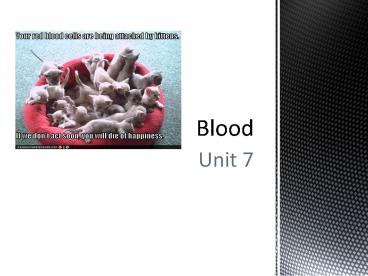Blood - PowerPoint PPT Presentation
1 / 28
Title:
Blood
Description:
The average red blood cell transfusion is approximately 3 pints. ... Type O-negative blood (red cells) can be transfused to patients of all blood types. – PowerPoint PPT presentation
Number of Views:150
Avg rating:3.0/5.0
Title: Blood
1
Blood
- Unit 7
2
What is blood?
- Considered a tissue because of all the different
cells - Has 3 main functions
- Transport
- Regulation
- Protection
3
What does it transport?
- Oxygen/Carbon Dioxide to and fro cells
- Nutrients to cells
- Waste from cells
- Hormones from glands to cells
- Heat
4
What does is regulate?
- pH
- Temperature
- Salt Balance
- Water Content
5
What does it protect?
- Clotting (loss of blood)
- Combatting toxins
6
Blood Stats
- Made in bone marrow
- 7 of your body weight
- Lives approx. 120 days
- Has 4 components
- Plasma Clear/yellow liquid
- Erythrocyte RBC
- Leukocyte WBC
- Thrombocyte Platelets
7
Bone Marrow-Overall View
8
Blood Components
- Plasma
- Clear to yellow liquid
- Acts as the vehicle the cells travel in (dilute
solution of hormones, sugar, amino acids, fat,
urea, platelets, and salts) - RBC (96)
- Biconcave Disc with hemoglobin (protein)
- Transports O2 /CO2
Where do the products carried by the plasma come
from and go??
9
Blood Components
- WBC (3)
- Large, blue to purple cells
- Fight disease/intruders, 6 kinds--(Neutrophil
most common, 55, kills bacteria and becomes pus
and dies) - Platelets (1)
- Tiny cells fragments
- Aid in clotting (internal and external)
10
(No Transcript)
11
Blood Under a Microscope
RBC
WBC
12
Boat-Like RBCs
13
Red Blood Cells (RBC)
14
Protective WBCs
15
(No Transcript)
16
Platelets
17
Platelet Plug
18
Microscope View of Blood Clot
19
Blood Type
BLOOD TYPES
1901 - Austrian Karl Landsteiner discovered human
blood groups. Before this time, blood
transfusions were performed, but doctors did not
understand why patients would die.
20
Blood Typing Genetics Review
- Blood Type is Controlled by 3 Alleles A, B, O
- -A and B are Co-Dominant (meaning??)
- -O is recessive
21
- Blood Typing Basics
- Antigen Protein on the surface of the red blood
cell, gives blood type identity. - There are 3 total A, B, Rh
- A is present A
- B is presentB
- Both A and B present AB
- None Present O
- Rh or -
22
Antigen Combinations
23
- Blood Typing Basics
- Antibodies Proteins found free-floating in the
bloodstream, will attack antigens on the RBC - There are 3 antibodies
- Anti-A
- Anti-B
- Anti-Rh
24
(No Transcript)
25
- Blood Testing and Transfusions
- AGGLUTINATION (the clumping of red blood cells
following a transfusion reaction likely fatal - Antigens and Antibodies Combine Causing a
Clot/Clump
26
(No Transcript)
27
Facts About Blood Need Every two seconds someone
in the U.S. needs blood. More than 41,000 blood
donations are needed every day. A total of 30
million blood components are transfused each year
in the U.S. The average red blood cell
transfusion is approximately 3 pints. The blood
type most often requested by hospitals is Type
O. The blood used in an emergency is already on
the shelves before the event occurs. Sickle cell
disease affects more than 70,000 people in the
U.S. About 1,000 babies are born with the disease
each year. Sickle cell patients can require
frequent blood transfusions throughout their
lives. More than 1.6 million people were
diagnosed with cancer last year. Many of them
will need blood, sometimes daily, during their
chemotherapy treatment. A single car accident
victim can require as many as 100 pints of blood.
28
Facts About Blood Supply The number of blood
donations collected in the U.S. in a year 15.7
million The number of blood donors in the U.S. in
a year 9.2 million Although an estimated 38 of
the U.S. population is eligible to donate, less
than 10 actually do each year. Blood cannot be
manufactured it can only come from generous
donors. Type O-negative blood (red cells) can be
transfused to patients of all blood types. It is
always in great demand and often in short
supply. Type AB-positive plasma can be transfused
to patients of all other blood types. AB plasma
is also usually in short supply.






























